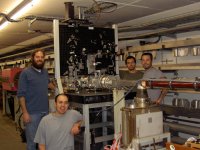 |
 |
|||||||||||||
|
|||||||||||||
|
|||||||||||||
|
It was supposed be the wrap-up meeting of a successful accelerator physics project. However, when the news came that the EU-funded EUROTeV was going to be extended, the meeting in Frascati, Italy, from 23 to 25 January turned into both a summary and a future-planning session. “We've got another year to go and the project is as useful now as it was at the kick-off meeting in 2004,” says scientific coordinator Nick Walker from DESY. The collaboration contributed big chunks of R&D to the Reference Design Report and thinks that most of the work can prove useful for projects beyond the ILC. “With the collected EUROTeV expertise in beam dynamics, optics design, positron source R&D and much more we’re almost regarded as an institution,” adds project coordinator Eckhard Elsen.
The next steps, apart from investing the leftover funds in the different work packages, are the final report due at the end of the year and a workshop in Uppsala, Sweden, in early September. The project enrolled some 100 postdocs and the coordinators expect that every one of them will present their results in Sweden. Despite the well-known problems with the UK funding, Britain continues to play an important role in EuroTeV, also in 2008. One sure topic of discussion will be a recent paper by the laser wire experts. In parallel with tests at KEK's ATF facility they installed a test system in DESY's PETRA ring. Laser wire is all about understanding the quality of the electron beam. Scientists need to know exactly how thick, dense and long a bunch of electrons is before it collides with its positron counter beam in order to maximise the collision rate. The laser wire system makes sure that all this information is available by shining a laser onto the particle beam, scanning through it and detecting the scattered photons. The experiments at DESY proved the case; however, more work is required to turn their system into a routinely used instrument. The first customers are already waiting: “The PETRA ring is just being remodelled and DESY wants to use our laser wire system for its new PETRA III lightsource. We are hoping to test prototypes of ultra fast laser beam scanners there,” says Stewart Boogert from John Adams Institute, Royal Holloway, University of London. The EUROTeV people think that it is this versatility and the generic nature of many of the research projects that will ensure that results will live on in many different regions of research. “Vibration and stabilisation studies are very important for any precision instrument,” explains Elsen, “and so much work has been done on developing software tools that we can think of a whole bunch of potential uses in projects other than CLIC and ILC.” Work will not be over when the final report is written. Design is followed by construction or prototyping. Many of the EUROTeV contributors put high hopes on the approval of a proposal in the EU's Seventh Framework Programme due end February which would support the use of accelerator infrastructures to test their ideas starting 2009. -- Barbara Warmbein |
|||||||||||||
| © International Linear Collider |
